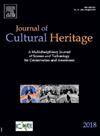Characterization of the imperial architectural ornament papers in the Yanqu Building, the Forbidden City
IF 3.3
2区 综合性期刊
0 ARCHAEOLOGY
引用次数: 0
Abstract
Architectural pasting ornament, as a quintessential traditional Chinese interior finishing technique utilizing paper and textile materials, was particularly prominent in imperial constructions during the Ming-Qing transitional period. The exquisitely preserved ornament papers were found in the Yanqu Building (1772 CE) within the Qianlong Garden complex of the Forbidden City. A multidisciplinary analytical approach incorporating ultra-depth 3D video microscopy, polarized light microscopy (PLM), scanning electron microscopy with energy-dispersive X-ray spectroscopy (SEM-EDS), Raman spectroscopy, and thermally assisted hydrolysis-methylation pyrolysis gas chromatography/mass spectrometry (THM-Py-GC/MS) was systematically employed to investigate materials of the architectural ornament papers including the printed papers, pigments, and adhesives. The findings reveal that the multi-layer papers comprised mulberry bark papers and bamboo papers; pigment analysis identified copper resinate in passionflower floral scroll and coiled dragon motifs, lead white in swastika motifs, and muscovite as ground layer; adhesives characterization demonstrated the use of animal glue and pine resin in paint, with starch for paper laminations. The ornament papers had been renovated at least twice. Significantly, the first scientific identification of copper resinate - a translucent green glaze pigment - in the architectural decorations of the Forbidden City, provides new material evidence for understanding the technical evolution of Qing imperial decorative practices.
紫禁城雁曲楼皇家建筑装饰的表征论文
建筑糊饰作为一种典型的中国传统室内装饰技术,利用纸张和纺织材料,在明清过渡时期的皇家建筑中尤为突出。保存精美的装饰纸是在紫禁城乾隆花园建筑群内的衍渠楼(公元1772年)中发现的。采用超深度3D视频显微镜、偏振光显微镜(PLM)、扫描电子显微镜与能量色散x射线光谱(SEM-EDS)、拉曼光谱、热辅助水解-甲基化热解气相色谱/质谱(THM-Py-GC/MS)等多学科分析方法,系统地研究了建筑装饰纸的材料,包括印刷纸、颜料和粘合剂。结果表明:多层纸主要由桑皮纸和竹纸组成;颜料分析发现,西番莲花卷和盘龙图案中含有铜树脂,卐字图案中含有铅白,而莫斯科云母为底层;胶粘剂的特性证明了在油漆中使用动物胶和松脂,在纸张层压中使用淀粉。装饰纸至少被翻新过两次。具有重要意义的是,在紫禁城的建筑装饰中首次科学地发现了铜树脂——一种半透明的绿色釉颜料——为了解清朝皇家装饰实践的技术演变提供了新的材料证据。
本文章由计算机程序翻译,如有差异,请以英文原文为准。
求助全文
约1分钟内获得全文
求助全文
来源期刊

Journal of Cultural Heritage
综合性期刊-材料科学:综合
CiteScore
6.80
自引率
9.70%
发文量
166
审稿时长
52 days
期刊介绍:
The Journal of Cultural Heritage publishes original papers which comprise previously unpublished data and present innovative methods concerning all aspects of science and technology of cultural heritage as well as interpretation and theoretical issues related to preservation.
 求助内容:
求助内容: 应助结果提醒方式:
应助结果提醒方式:


